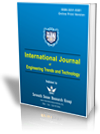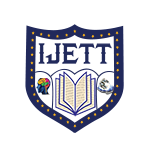An Investigation and Design of Conceptual Framework of Digital Twin with Industry 4.0 Enabling Technologies
An Investigation and Design of Conceptual Framework of Digital Twin with Industry 4.0 Enabling Technologies |
||
 |
 |
|
| © 2025 by IJETT Journal | ||
| Volume-73 Issue-2 |
||
| Year of Publication : 2025 | ||
| Author : Sunayana Jadhav, Sanjay Lohar, Anil Hingmire, Amrita Ruperee, Trupti Shah |
||
| DOI : 10.14445/22315381/IJETT-V73I2P112 | ||
How to Cite?
Sunayana Jadhav, Sanjay Lohar, Anil Hingmire, Amrita Ruperee, Trupti Shah, "An Investigation and Design of Conceptual Framework of Digital Twin with Industry 4.0 Enabling Technologies," International Journal of Engineering Trends and Technology, vol. 73, no. 2, pp. 141-154, 2025. Crossref, https://doi.org/10.14445/22315381/IJETT-V73I2P112
Abstract
With the invention of Industry 4.0, a very revolutionary and smart manufacturing paradigm called Digital Twin (DT) was introduced. This system ensures deep penetration to the application of the massive data collected through the generation of information and digital technologies. Research and academia consider it a cutting-edge technology, as it has also successfully claimed its position in the industry. Due to the complex nature of handling and merging varied data types, the potential has been partially realized, and there is much more to be explored. It is essential for researchers and engineers to clearly identify the tools and technologies that suit the DT system. This review article provides a state-of-the-art review of key enabling technologies and the viability of DT with an industry approach. A generic framework consisting of tools, enabling technologies and their correlation with the digital twin is also explained. A generalized data flow and corresponding tools required for the DT system are explained. Finally, a brief discussion on challenges and future research outlook is provided.
Keywords
Digital Twin, Industry 4.0, Enabling technologies, DT framework, Interaction.
References
[1] Weifei Hu et al., “Digital Twin: A State-of-the-Art Review of its Enabling Technologies, Applications and Challenges,” Journal of Intelligent Manufacturing and Special Equipment, vol. 2, no. 1, pp. 1-34, 2021.
[CrossRef] [Google Scholar] [Publisher Link]
[2] Aidan Fuller et al., “Digital Twin: Enabling Technologies, Challenges and Open Research,” IEEE Access, vol. 8, pp. 108952-108971, 2020.
[CrossRef] [Google Scholar] [Publisher Link]
[3] Edward Glaessgen, and David Stargel, “The Digital Twin Paradigm for Future NASA and U.S. Air Force Vehicles,” 53rd AIAA Structures, Structural Dynamics, and Materials Conference, Honolulu, Hawaii, 2012.
[CrossRef] [Google Scholar] [Publisher Link]
[4] Mengnan Liu et al., “Review of Digital Twin about Concepts, Technologies, and Industrial Applications,” Journal of Manufacturing Systems, vol. 58, pp. 346-361, 2021.
[CrossRef] [Google Scholar] [Publisher Link]
[5] Yubao Chen, “Integrated and Intelligent Manufacturing: Perspectives and Enablers Engineering, Engineering, vol. 3, no. 5, pp. 588-595, 2017.
[CrossRef] [Google Scholar] [Publisher Link]
[6] Qinglin Qi et al., “Enabling Technologies and Tools for Digital Twin,” Journal of Manufacturing Systems, vol. 58, pp. 3-21, 2021.
[CrossRef] [Google Scholar] [Publisher Link]
[7] Fei Tao et al., “Digital Twin in Industry: State-f-the-Art,” IEEE Transactions on Industrial Informatics, vol. 15, no. 4, pp. 2405-2415, 2019.
[CrossRef] [Google Scholar] [Publisher Link]
[8] Eric VanDerHorn, and Sankaran Mahadevan, “Digital Twin: Generalization, Characterization and Implementation,” Decision Support Systems, vol. 145, 2021.
[CrossRef] [Google Scholar] [Publisher Link]
[9] Barbara Rita Barricelli, Elena Casiraghi, and Daniela Fogli, “A Survey on Digital Twin: Definitions, Characteristics, Applications, and Design Implications,” IEEE Access, vol. 7, pp. 167653-167671, 2019.
[CrossRef] [Google Scholar] [Publisher Link]
[10] Zhiheng Zhao et al., “IoT and Digital Twin enabled Smart Tracking for Safety Management,” Computers & Operations Research, vol. 128, 2021.
[CrossRef] [Google Scholar] [Publisher Link]
[11] Itxaro Errandonea, Sergio Beltrán, and Saioa Arrizabalaga, “Digital Twin for Maintenance: A Literature Review,” Computers in Industry, vol. 123, 2020.
[CrossRef] [Google Scholar] [Publisher Link]
[12] André Barthelmey et al., “Dynamic Digital Twin for Predictive Maintenance in Flexible Production Systems,” IECON 2019 - 45th Annual Conference of the IEEE Industrial Electronics Society, Lisbon, Portugal, pp. 4209-4214, 2019.
[CrossRef] [Google Scholar] [Publisher Link]
[13] Panagiotis Aivaliotis, Konstantinos Georgoulias, and Kosmas Alexopoulos, “Using Digital Twin for Maintenance Applications in Manufacturing: State of the Art and Gap Analysis,” IEEE International Conference on Engineering, Technology, and Innovation (ICE/ITMC), Valbonne Sophia-Antipolis, France, pp. 1-5, 2019.
[CrossRef] [Google Scholar] [Publisher Link]
[14] Michele Compare, Piero Baraldi, and Enrico Zio, “Challenges to IoT-Enabled Predictive Maintenance for Industry 4.0,” IEEE Internet of Things Journal, vol. 7, no. 5, pp. 4585-4597, 2019.
[CrossRef] [Google Scholar] [Publisher Link]
[15] Kamil Židek et al., “Digital Twin of Experimental Smart Manufacturing Assembly System for Industry 4.0 Concept,” Sustainability, vol. 12, no. 9, pp. 1-16, 2020.
[CrossRef] [Google Scholar] [Publisher Link]
[16] Bin He, and Kai-Jian Bai, “Digital Twin-based Sustainable Intelligent Manufacturing: A Review,” Advances in Manufacturing, vol. 9, pp. 1-21, 2021.
[CrossRef] [Google Scholar] [Publisher Link]
[17] Edoardo Fadda, Guido Perboli, and Roberto Tadei, “Customized Multi-Period Stochastic Assignment Problem for Social Engagement and Opportunistic IoT,” Computers & Operations Research, vol. 93, pp. 41-50, 2018.
[CrossRef] [Google Scholar] [Publisher Link]
[18] Dimitrios Georgakopoulos et al., “Internet of Things and Edge Cloud Computing Roadmap for Manufacturing,” IEEE Cloud Computing, vol. 3, no. 4, pp. 66-73, 2016.
[CrossRef] [Google Scholar] [Publisher Link]
[19] Prakashan Korambath et al., “A Smart Manufacturing Use Case: Furnace Temperature Balancing in Steam Methane Reforming Process via Kepler Workflows,” Procedia Computer Science, vol. 80, pp. 680-689, 2016.
[CrossRef] [Google Scholar] [Publisher Link]
[20] Caterina Bigoni, and Jan S. Hesthaven, “Simulation-Based Anomaly Detection and Damage Localization: An Application to Structural Health Monitoring,” Computer Methods in Applied Mechanics and Engineering, vol. 363, 2020.
[CrossRef] [Google Scholar] [Publisher Link]
[21] Michael G. Kapteyn, David J. Knezevic, and Karen Willcox, “Toward Predictive Digital Twins via Component-Based Reduced-Order Models and Interpretable Machine Learning,” AIAA Scitech 2020 Forum, Orlando, FL, 2020.
[CrossRef] [Google Scholar] [Publisher Link]
[22] Jared Willard et al., “Integrating Physics-Based Modeling with Machine Learning: A Survey,” arXiv, vol. 1, no. 1, pp. 1-34, 2020.
[Google Scholar] [Publisher Link]
[23] Michael Nielsen, Neural Networks and Deep Learning, Determination Press, 2015.
[Google Scholar] [Publisher Link]
[24] Shiqian Ke et al., A Enhanced Interaction Framework Based on VR, AR and MR in Digital Twin, Procedia CIRP, vol. 83, pp. 753-758, 2019.
[CrossRef] [Google Scholar] [Publisher Link]
[25] Arquimedes Canedo, “Industrial IoT Lifecycle via Digital Twins,” Proceedings of the Eleventh IEEE/ACM/IFIP International Conference on Hardware/Software Codesign and System Synthesis, Pennsylvania, Pittsburgh, 2016.
[CrossRef] [Google Scholar] [Publisher Link]
[26] Adriana de Souza e Silva, and Daniel M. Sutko, Digital Cityscapes: Merging Digital and Urban Playspaces, Peter Lang, 2010.
[Google Scholar] [Publisher Link]
[27] Paul Milgram, and Fumio Kishino, “A Taxonomy of Mixed Reality Visual Displays,” IEICE Transactions on Information and Systems, vol. E77-D, no. 12, pp. 1321-1329, 1994.
[Google Scholar] [Publisher Link]
[28] Christian Petersson Nielsen, Elias Ribeiro da Silva, and Fei Yu, “Digital Twins and Blockchain - Proof of Concept,” Procedia CIRP, vol. 93, pp. 251-255, 2020.
[CrossRef] [Google Scholar] [Publisher Link]
[29] Hyun-Soo Lee et al., “RFID-Based Real-Time Locating System for Construction Safety Management,” Journal of Computing in Civil Engineering, vol. 26, no. 3, pp. 366-377, 2012.
[CrossRef] [Google Scholar] [Publisher Link]
[30] Zhiheng Zhao et al., “IoT and Digital Twin Enabled Smart Tracking for Safety Management,” Computers and Operations Research, vol. 128, 2021.
[CrossRef] [Google Scholar] [Publisher Link]
[31] Naga Sai Ravali Challa et al., “Design and Implementation of Bluetooth-Beacon Based Indoor Positioning System,” IEEE International WIE Conference on Electrical and Computer Engineering (WIECON-ECE), Bangalore, India, pp. 1-4, 2019.
[CrossRef] [Google Scholar] [Publisher Link]
[32] Ibrahim Abaker Targio Hashem et al., “The Rise of “Big Data” on Cloud Computing: Review and Open Research Issues,” Information Systems, vol. 47, pp. 98-115, 2015.
[CrossRef] [Google Scholar] [Publisher Link]
[33] Shanhe Yi, Cheng Li, and Qun Li, “A Survey of Fog Computing: Concepts, Applications and Issues,” Proceedings of the 2015 Workshop on Mobile Big Data, Hangzhou, China, pp. 37-42, 2015.
[CrossRef] [Google Scholar] [Publisher Link]
[34] Qinglin Qi, and Fei Tao, “Digital Twin and Big Data towards Smart Manufacturing and Industry 4.0: 360 Degree Comparison,” IEEE Access, vol.6. pp. 3585-3593, 2018.
[CrossRef] [Google Scholar] [Publisher Link]
[35] Ying Liu et al., “Identifying Helpful Online Reviews: A Product Designer’s Perspective,” Computer-Aided Design, vol. 45, no. 2, pp. 180-194, 2013.
[CrossRef] [Google Scholar] [Publisher Link]
[36] Fei Tao et al., “IoT-Based Intelligent Perception and Access of Manufacturing Resource Toward Cloud Manufacturing,” IEEE Transactions on Industrial Informatics, vol. 10, no. 2, pp. 1547-1557, 2014.
[CrossRef] [Google Scholar] [Publisher Link]
[37] Carl Boettiger, “An Introduction to Docker for Reproducible Research,” ACM SIGOPS Operating Systems Review, vol. 49, no. 1, pp. 71-79, 2015.
[CrossRef] [Google Scholar] [Publisher Link]
[38] Kirill Borodulin et al., “Towards Digital Twins Cloud Platform: Microservices and Computational Workflows to Rule a Smart Factory,” Proceedings of the10th International Conference on Utility and Cloud Computing, Association for Computing Machinery, Texas, Austin, USA, pp. 209-210, 2017.
[CrossRef] [Google Scholar] [Publisher Link]
[39] Charles R. Farrar, and Keith Worden, “An Introduction to Structural Health Monitoring,” Philosophical Transactions of the Royal Society a Mathematical, Physical and Engineering Sciences, vol. 365, no. 1851, pp. 303-315, 2007.
[CrossRef] [Google Scholar] [Publisher Link]
[40] Christian Soize, Uncertainty Quantification: An Accelerated Course with Advanced Applications in Computational Engineering, Springer Cham, 2017.
[CrossRef] [Google Scholar] [Publisher Link]
[41] P. Papachatzakis, N. Papakostas, and G. Chryssolouris, “Condition Based Operational Risk Assessment an Innovative Approach to Improve Fleet and Aircraft Operability: Maintenance Planning,” 1st European Air and Space Conference, pp. 121-126, 2007.
[Google Scholar] [Publisher Link]
[42] C. Okoh et al., “Overview of Remaining Useful Life Prediction Techniques in Through- Life Engineering Services,” Procedia CIRP, vol. 16, pp. 158-163, 2014.
[CrossRef] [Google Scholar] [Publisher Link]
[43] Junfeng Xie et al., “A Survey of Blockchain Technology Applied to Smart Cities: Research Issues and Challenges,” IEEE Communications Surveys & Tutorials, vol. 21, no. 3, pp. 2794-2830, 2019.
[CrossRef] [Google Scholar] [Publisher Link]
[44] Abdallah Moubayed, Ahmed Refaey, and Abdallah Shami, “Software-Defined Perimeter (SDP): State of the Art Secure Solution for Modern Networks,” IEEE Network, vol. 33, no. 5, pp. 226-233, 2019.
[CrossRef] [Google Scholar] [Publisher Link]
[45] Tim Weingärtner, “Tokenization of Physical Assets and the Impact of IoT and AI,” EU Blockchain Observatory and Forum, pp. 1-16, 2019.
[Google Scholar] [Publisher Link]
[46] Heber Dominik, and Groll Marco, “Towards a Digital Twin: How the Blockchain can Foster E/E-Traceability in Consideration of Model-Based Systems Engineering,” Proceedings of the 21st International Conference on Engineering Design (ICED 17), Vancouver, Canada, pp. 321-330, 2017.
[Google Scholar] [Publisher Link]

